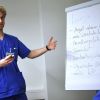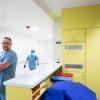How to become a medical doctor in Germany
This guide provides information for doctors to be licensed and helps future-doctors find the path to become a doctor in Germany.

Applying to medical school
Admission to medical universities in Germany used to be extremely competitive. Medical, pharmacy, veterinary medicine, and dentistry training spots were limited or numerus clausus (NC, Latin for "closed number"). Universities had a quota and places are given to students with the highest Abitur grades from the Stiftung für Hochschulzulassung or an equal degree from other countries.
But a wider range of applicants gets a chance now. Following a decision by the Standing Conference of the Länder Ministers of Education and Cultural Affairs, the allocation of university places for studying medicine has been changed. The 'numerus clausus' will continue to exist, and about 20 percent of the study places in human medicine will still go to the applicants with the best grades. But what is new is that greater weight is being attached in the universities' selection procedures to a person's CV, motivation and personal commitment. These criteria will also play a role in the Standard Assessment Test for Students of Medicine (TMS). More and more universities are offering the TMS test, which also makes access possible for study applicants without top grades.
Secondary diplomas obtained inside the European Union are mutually recognized. Students from outside European Union have to apply for the Hochschulzugangsberechtigung (HZB). The Akademisches Auslandsamt (International Students' Office) of the university evaluates qualifications based on the anabin database. International applicants may be able to apply directly to the universities via the Application Services for International University Applications, known as Uni-Assist. Between 4 and 6 percent of spots are held open for Bildungsauslaender (foreign students). The German Academic Exchange Service (DAAD) provides comprehensive information on how to apply for a spot in a German university.
If your school-leaving certificate is not recognized in Germany, there is another option. Prospective students can enroll in a Studienkolleg (foundation course) of one year that leads to a Feststellungsprüfung (university qualification assessment examination). With these results, applicants can try again for a spot in a medical program.
In addition to these requirements, some programs require a Test für Medizinische Studiengänge (TMS) or Medizinertest. This tests knowledge, experience and general ability to study. The University of Heidelberg acts as a TMS coordination site.
Where to study medicine in Germany
There are over 35 public medical faculties in Germany and about 80,000 medical students. Unlike places like the USA, most schools offer equally respected programs. However, different faculties have different areas of expertise so if you have a specialty you prefer, inquire at individual schools. Zeit Online also compiles a helpful list of school rankings by field of study. Some of the most popular programs can be found at:
- Universität Heidelberg – The "Harvard of German Medical Schools” is the most competitive school to get in to. It has a highly respected international reputation and the town has a well-developed student culture. It was founded in 1386 making it the oldest university in Germany.
- Charité – Universitätsmedizin – This is the oldest and most prominent hospital and medical school in Berlin. Formed by a merger of the programs at Humboldt Universität and Freie Universität, Charité is one of Germany's most research-intensive medical institutions. This is also one of the best settings for international students with much of the online material, coursework, and instruction in English, but excellent German language skills are still required in order to work with patients.
- Universität Witten/Herdecke – This is the oldest private university in Germany with a prestigious reputation. Applicants must endure rigorous testing to enter the school and tuition is much more expensive than public schools (though still much less than schools in North America).
- Universitätsklinikum Tübingen – One of the oldest classical universities, the medical department is internationally renowned and associated with several medical Nobel laureates.
- Universität Freiburg – This university town has students from around the globe with a medical staff of over 10,000 professionals.
- Universität zu Lübeck – Famed for its work in medical research, the Lübeck Medical School focuses on fighting infection & inflammation, brain, behavior and metabolism, genetics and biomedical technologies.
Funding Medical School in Germany
For most international students, tuition and fees are surprisingly low in Germany. No tuition fees are charged for doctoral study at public universities in Germany, but for the study visa you will be required to show proof you can support yourself. This is estimated to be about 8,000 Euros a year, though cost of living varies greatly around the country. Semester fees are paid to the student administration (AstA) and cover everything from student IDs to access on the city’s public transport. They usually cost no more than 250 euro.
For help funding your education, there are several resources:
DAAD: Germany’s largest scholarship provider with excellent English information.
Bundesausbildungsförderungsgesetz (Federal Student Financial Aid Program or BAföG): Aimed at German nationals and EU students, this fund provides for some select foreigners such as refugees.
Medical School Coursework & Testing
Once accepted, medical training covers both pre-clinical studies and practical application. This is divided into basic science (two years), clinical science (three years), and final clinical year. The Approbationsordnung (Licensing Regulations for Physicians) details the specifics of what is required:
- Undergraduate medical studies of no fewer than six years and three months (a minimum of 12 terms with each term lasting about 6 months) at a university or equivalent academic institution.
- 48 consecutive weeks of practical training (practical year)
- First aid training
- Three months of nursing experience
- Four-month clinical elective
The first two years are known as Vorklinik and cover subjects like physics, chemistry, biology, anatomy, physiology, biochemistry, medical terminology, medical psychology, and sociology and introduction into clinical medicine. Klinik follows with hands-on training. The first aid course, elective subject, and three months of work experience in nursing can be completed anywhere, including outside of Germany. The last two semesters of medical training (one year) consist of an internship or PJ (Praktisches Jahr) at a medical facility.
Medical Examination or Approbation in Germany
This state exam, the Approbationsordnung für Ärzte (Regulation of the Licensing of Doctors or AppOÄ), takes place in three stages:
M1: The first stage of the medical examination, Physicum, takes place after two years of study in the field of medicine. It is based on anatomy, biochemistry, and physiology and is a written and oral-practical.
M2: The second stage takes place after five years of study and successful completion of the first exam. It is a written case-related exam.
M3: The third stage takes place one year after completion of the second stage following a total of six years of study in the field of medicine. It is an oral/practical examination.
The written examination dates can be found on the website of the Instituts für medizinische und pharmazeutische Prüfungsfragen in Mainz.
Passing the Approbation earns students their medical license and right to practice medicine. The license is permanent, valid for all of Germany and can only be revoked for disciplinary reasons. The majority of doctors continue on to write their dissertation or thesis and earn the title of “Dr. med”. Some forward-thinking students complete their dissertation in year three or four so they can hold the title and increase their job prospects as soon as they have passed the last test.
Recognition of Foreign Trained Doctors in Germany
Physicians who have completed their medical training outside of the European Union and EEA may still practice medicine in Germany, but have some hoops to jump through to get the Approbation.
EU/EEA/Switzerland Doctors - Eligible for a full license which offers an unlimited permit to practice.
Non-EU/EEA/Switzerland Doctors – Education will be assessed for equivalency. Depending on the evaluation they may be offered full license or a provisional license with time to prepare for an assessment test.
The Oberste Landesgesundheitsbehörde (state health authorities) evaluates foreign doctors’ education to judge if it is Gleichwertigkeit (equivalent) to medical training in Germany. Some Bundesländer only have one medical license agency known as Approbationsbehörde, while other Federal States have several medical license agencies and each requires specific documents with official German translation be submitted. They may include passport, Führungszeugnis (clean criminal record), Ärztliche Bescheinigung (certificate of health), proof of German knowledge (certification of at least B2 level plus a specific Medical German test - Level C1 of CEFR), birth certificate, CV (German format, in German), and a copy of degree.
If the relevant medical license authority finds significant differences between the medical education of the applicant’s home country and Germany, it may insist on the taking of an equivalency or assessment test. The assessment of education and professional experience is a case-by-case review.
The test is a clinical-practical test with patient presentation that takes between 60 and 90 minutes and can only be repeated two times. While preparing for this test, foreign doctors are given a provisional license and adjustment period, Anpassungszeit (maximum two years), before the test must be taken. At this time, foreign doctors do not hold a full license and restricted to similar studies and practical skills as the PJ.


